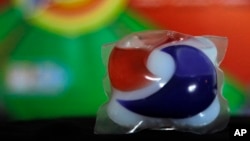Every day, humans are exposed to thousands of chemicals that are considered harmless, but - in combination - may cause cancer. That is the conclusion of a two-year study by a high profile task force of scientists investigating the cancer-causing potential of chemical mixtures.
Between the time we wake up in the morning and walk out the front door, we are exposed to literally thousands of chemicals.
“We’re talking about everything that could be from basic minerals – elements like copper, nickel – to pesticides that are used in things like cosmetics and hair sprays and nail polishes and food wrappers,” says Linda Gulliver, who is on the medical faculty of Otago University in Dunedin, New Zealand.
Gulliver was part of a group of 174 scientists from 28 countries charged with looking at the cancer-causing capabilities of 85 chemicals that are ubiquitous in our environment.
While the chemicals are safe on their own, according to Gulliver, the task force concluded that a stew of those compounds can stimulate cancer in human cells.
Working in groups, the scientists investigated how a variety of chemical mixtures could lead to the development of cancer.
Gulliver’s team looked at the ability of different combinations to promote the unchecked multiplication of malignant human cells.
“The $64 million dollar question that everybody wants to ask is, “Which ones [chemicals] should we be looking out for?” And the answer to that is we don’t know yet.”
The task force’s conclusions are published in the journal Carcinogenesis.
Gulliver says the current research approach to determine whether chemicals cause cancer - testing them one at a time - results in a long list of supposedly “safe” chemicals. She and her colleagues say, that needs to change.
“We definitely need certain research based around the fact that we know some of these chemicals and mixtures could potentiate each other - the effects - to find out what mixtures of chemicals would be more harmful than others; what groups of chemicals, when together, would produce more harmful effects. And at the moment, that is not known,” says Gulliver.
An estimated one in five cancers has been linked to chemical exposure, even if the affected individual is found to lead a “healthy” lifestyle.
And as the study shows, it may well be the culprit is not a single chemical, but exposure to many compounds simultaneously that increases the risk of cancer.




